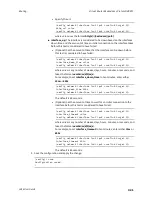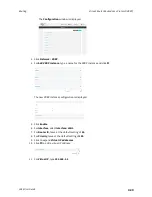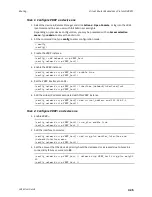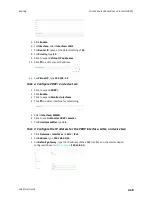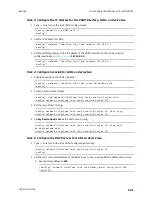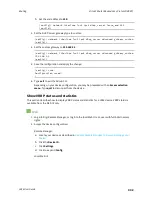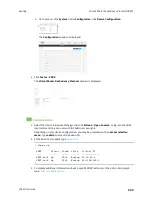
Routing
Virtual Router Redundancy Protocol (VRRP)
LR54 User Guide
419
7. (Optional) For backup devices, enable the ability for the device to monitor the master device.
This allows a backup VRRP device to monitor the master device, and increase its priority when
the master device is failing SureLink tests. This can allow a device functioning as a backup
device to promote itself to master.
(config)> network vrrp VRRP_test vrrp_plus monitor_master true
(config)>
8. Configure the VRRP interface:
a. Configure the VRRP interface's DHCP server to use a custom gateway that corresponds to
one of the VRRP virtual IP addresses:
i. Set the DHCP server gateway type to custom:
(config)> network interface lan1 ipv4 dhcp_server advanced gateway
custom
(config)>
ii. Determine the VRRP virtual IP addresses:
(config)> show network vrrp VRRP_test virtual_address
0 192.168.3.3
1 10.10.10.1
(config)>
iii. Set the custom gateway to one of the VRRP virtual IP addresses. For example:
(config)> network interface lan1 ipv4 dhcp_server advanced
gateway_custom 192.168.3.3
(config)>
b. For backup devices, set the default gateway to the IP address of the VRRP interface on the
master device. For example:
(config)> network interface lan1 ipv4 gateway 192.168.3.1
(config)>
c. For backup devices, enable and configure SureLink on the VRRP interface.
i. Determine the VRRP interface. Generally, this should be a LAN interface; VRRP+ will
then monitor the LAN using SureLink to determine if the interface has network
connectivity and promote a backup to master if SureLink fails.
(config)> show network vrrp VRRP_test interface
/network/interface/lan1
(config)>
ii. Enable SureLink on the interface:
(config)> network interface lan1 ipv4 surelink enable true
(config)>

















